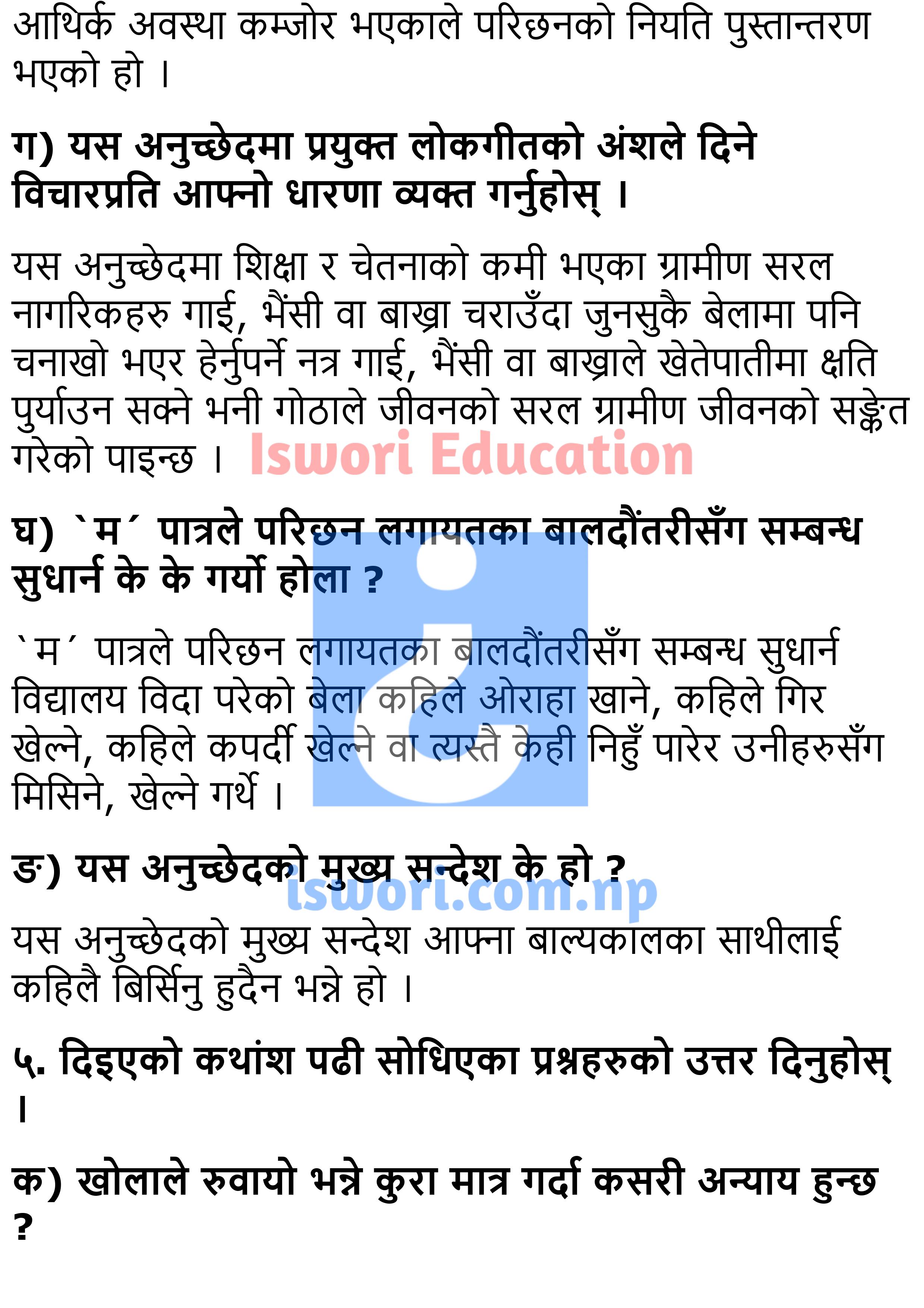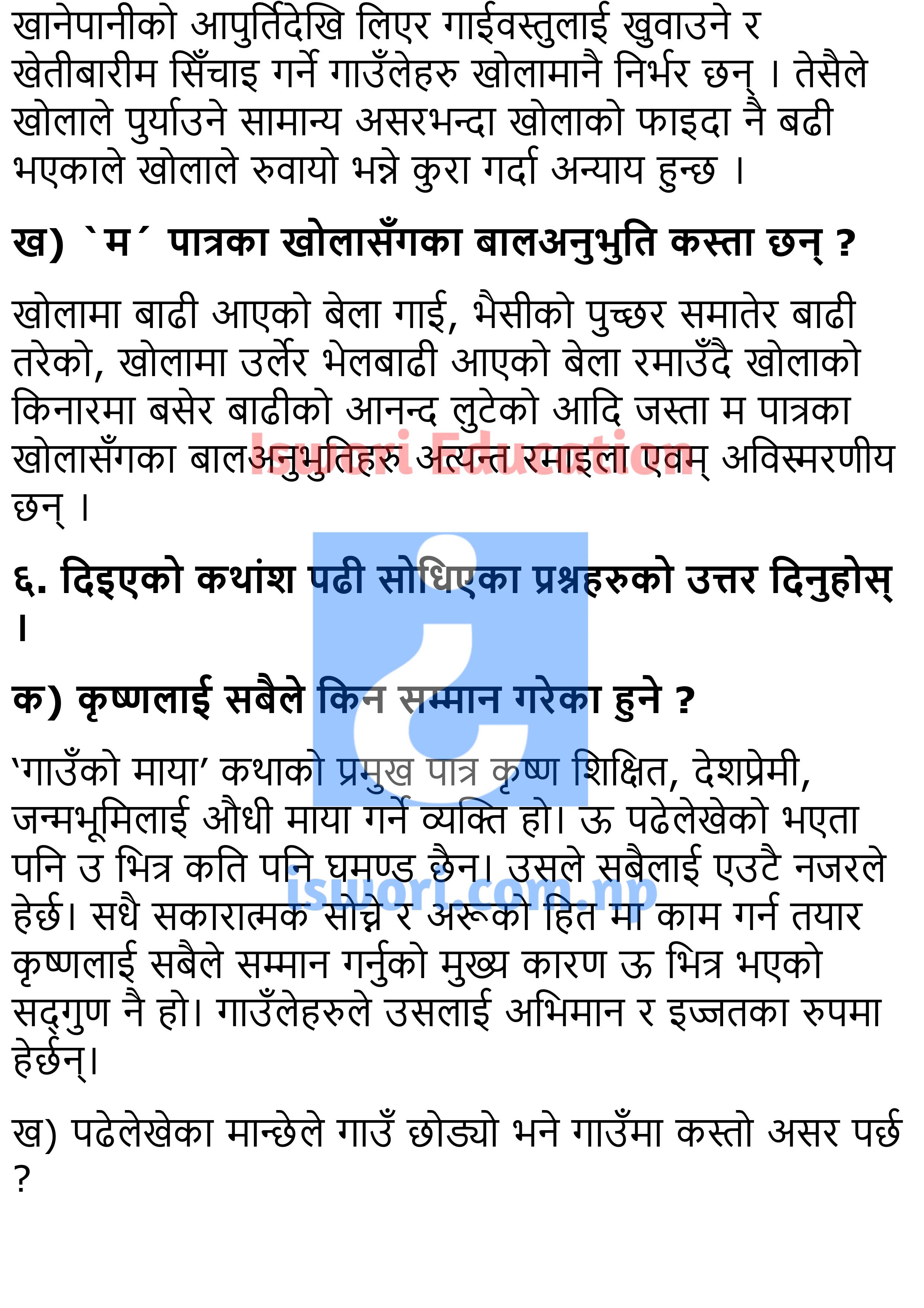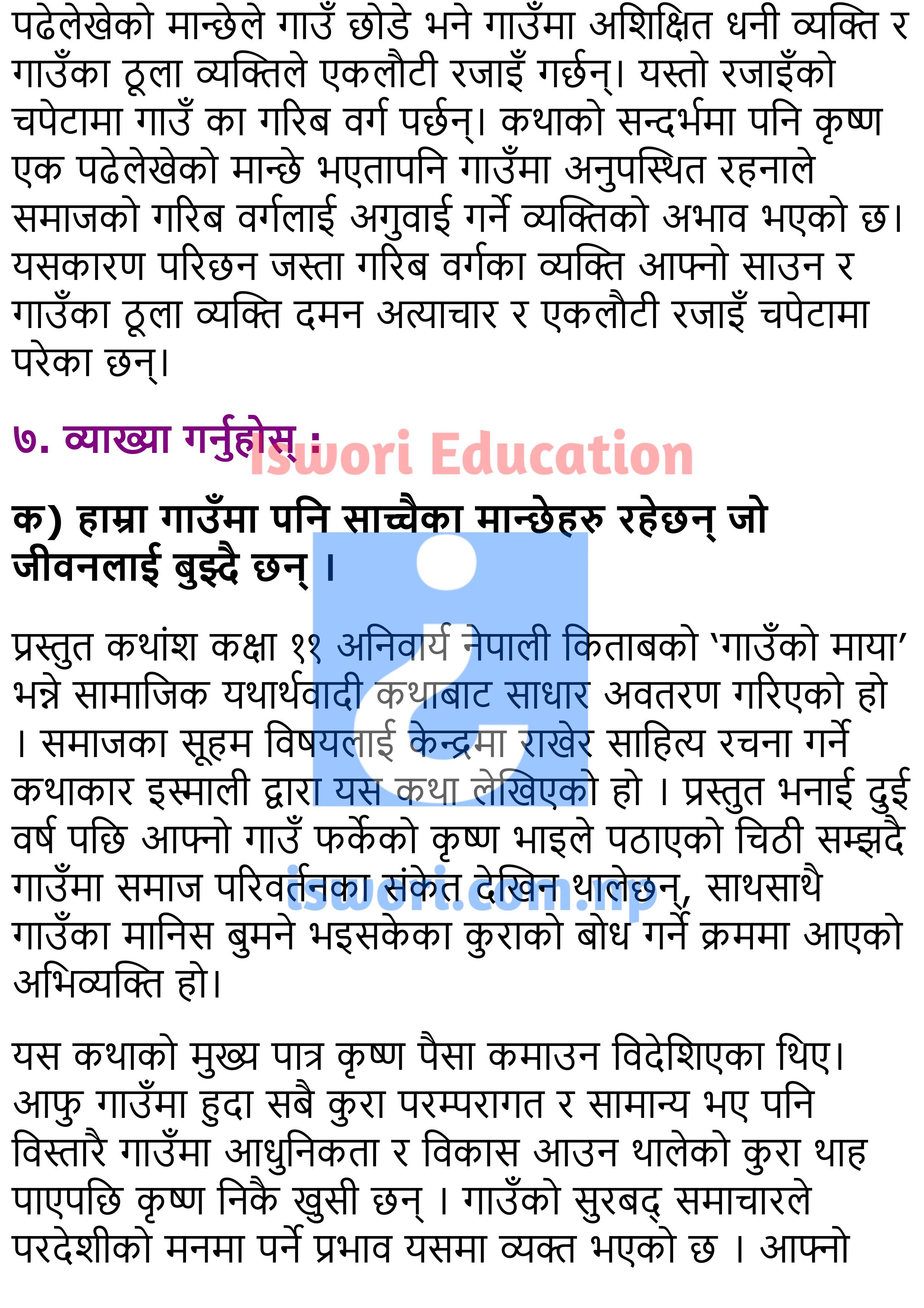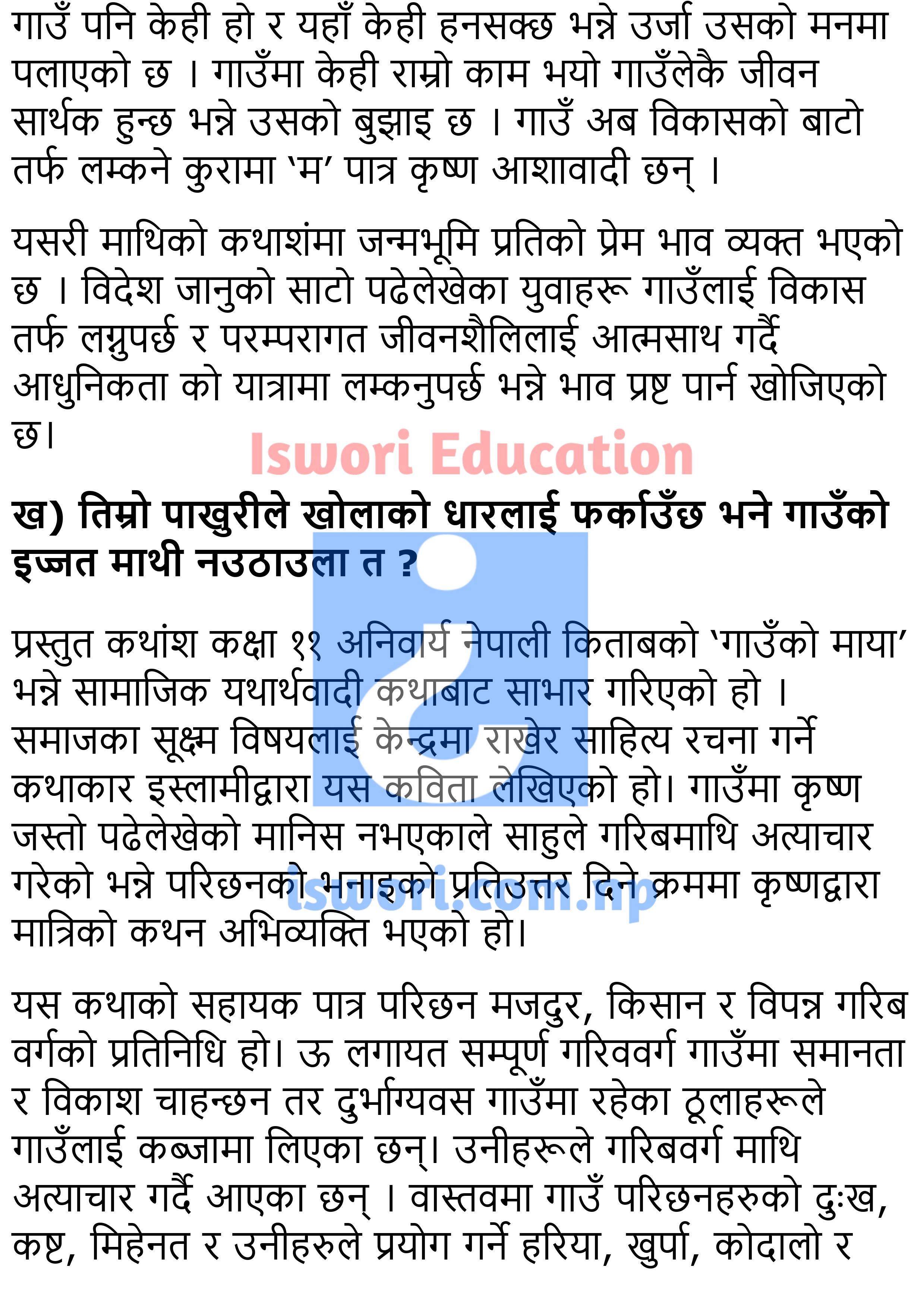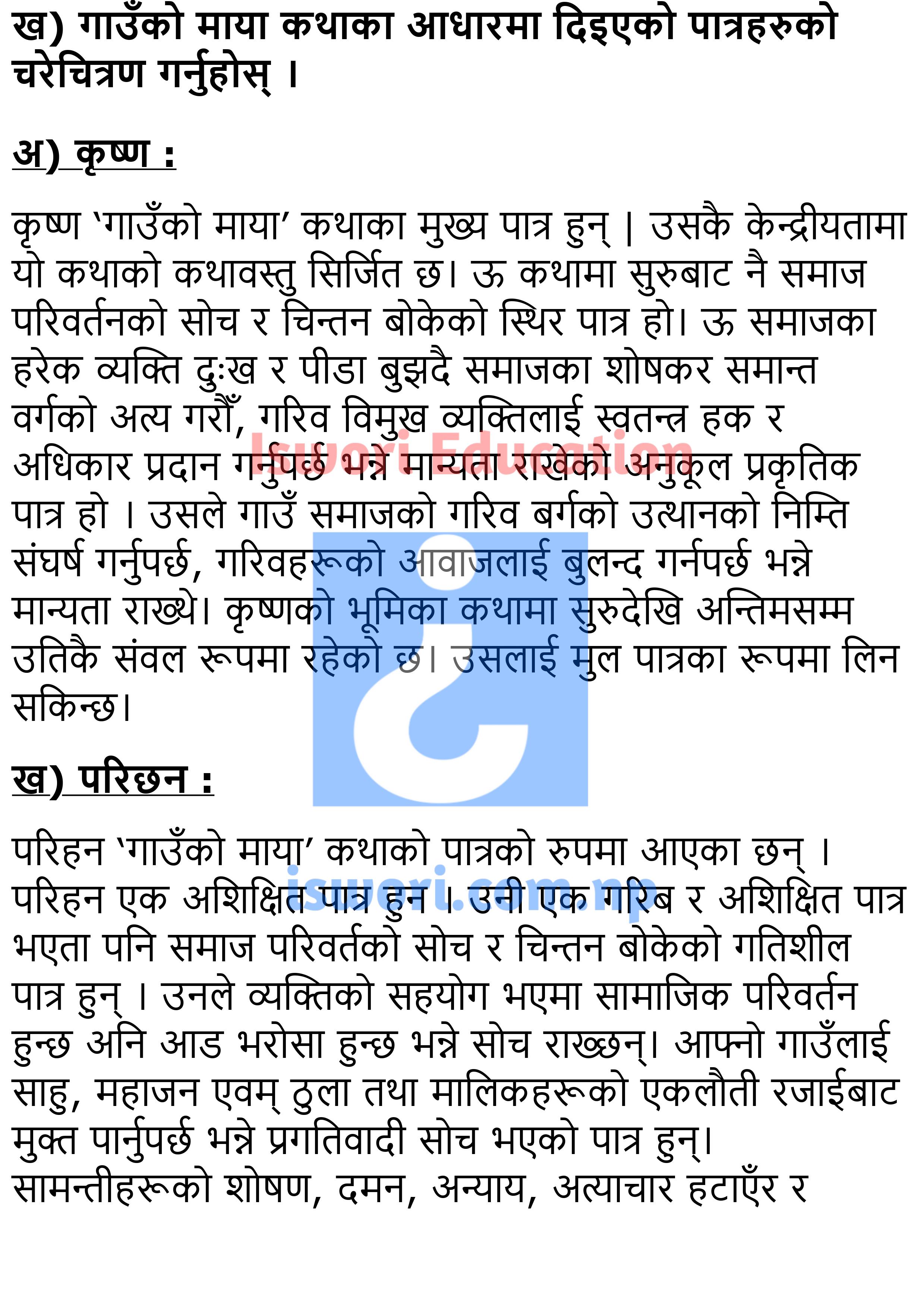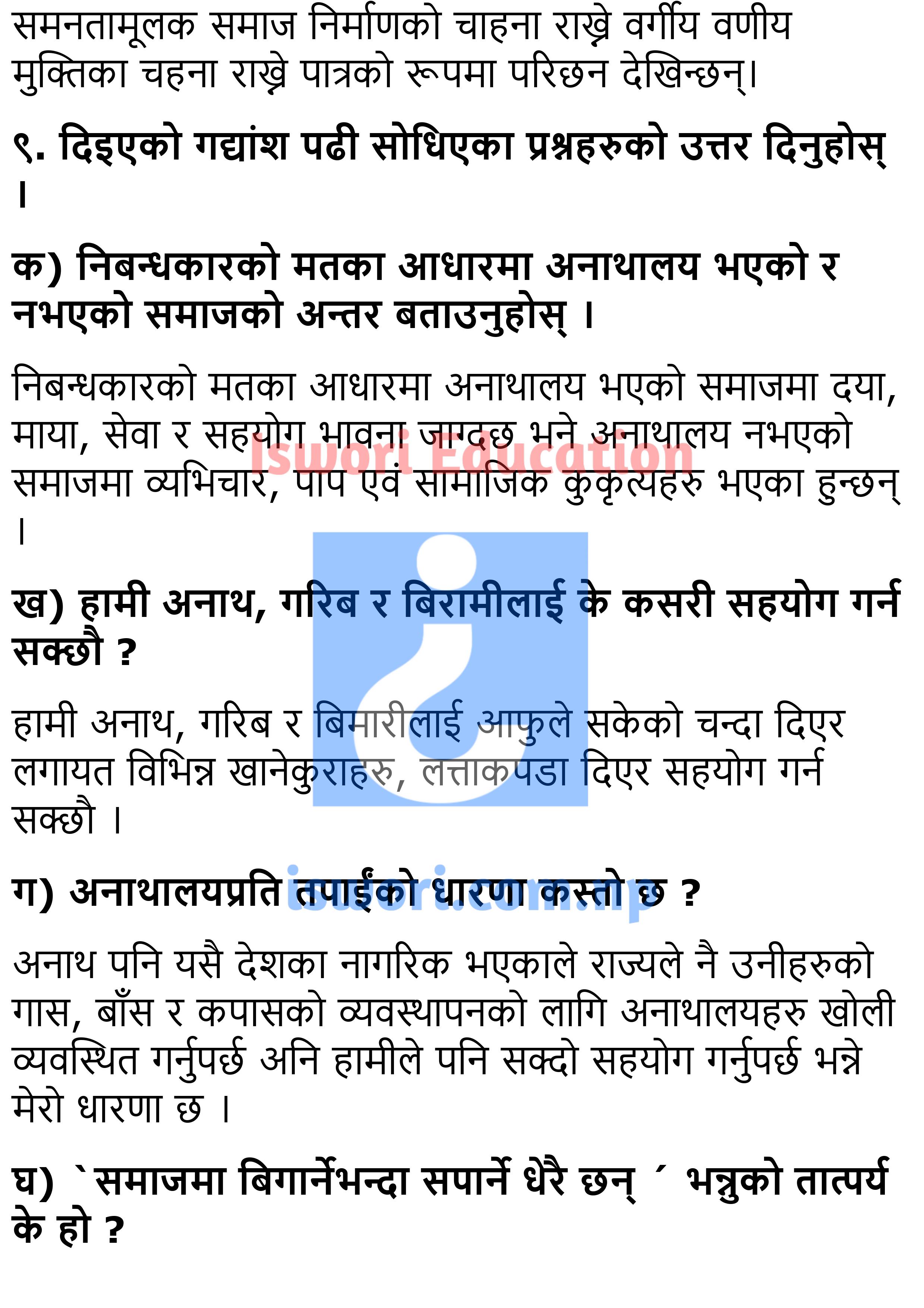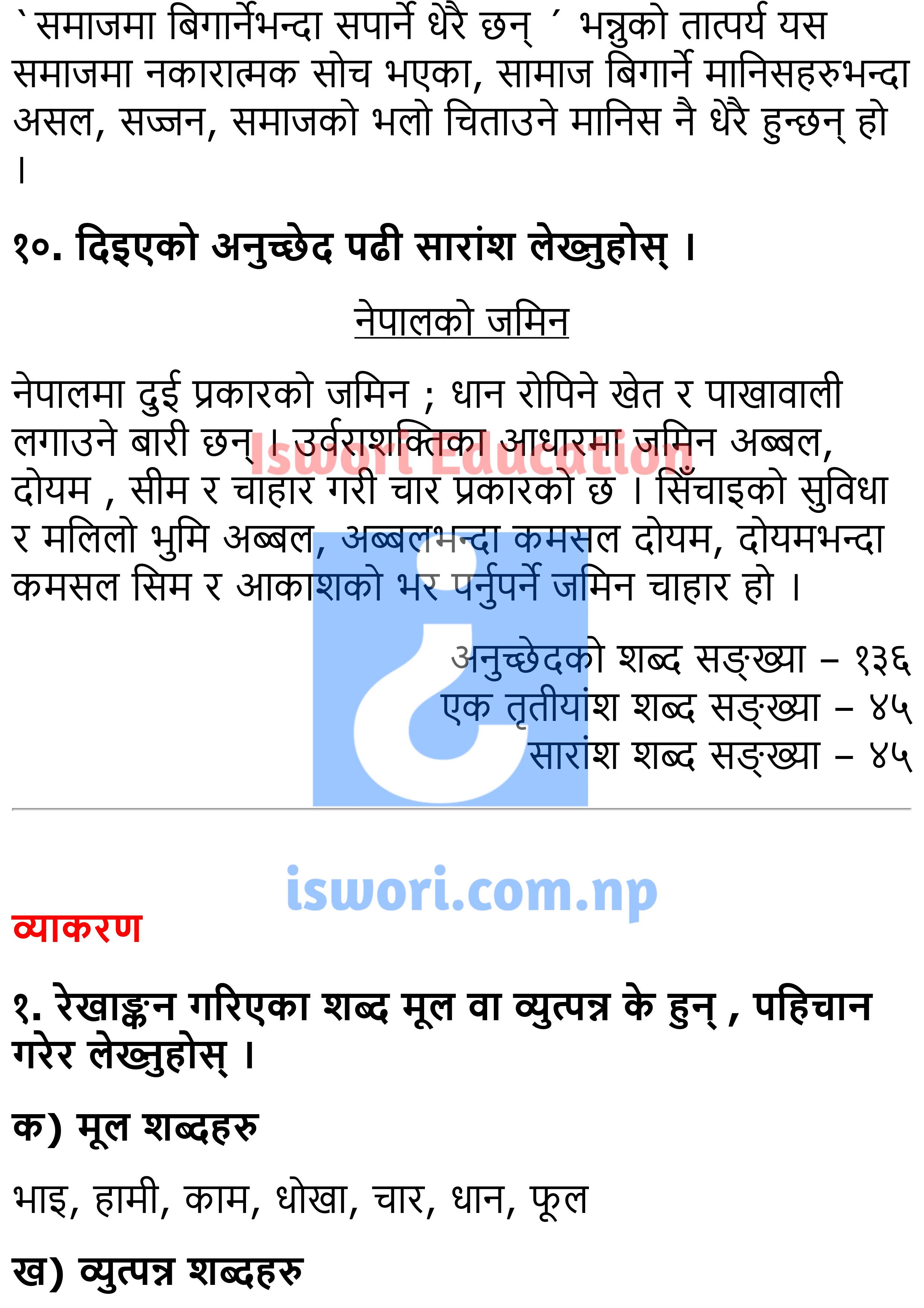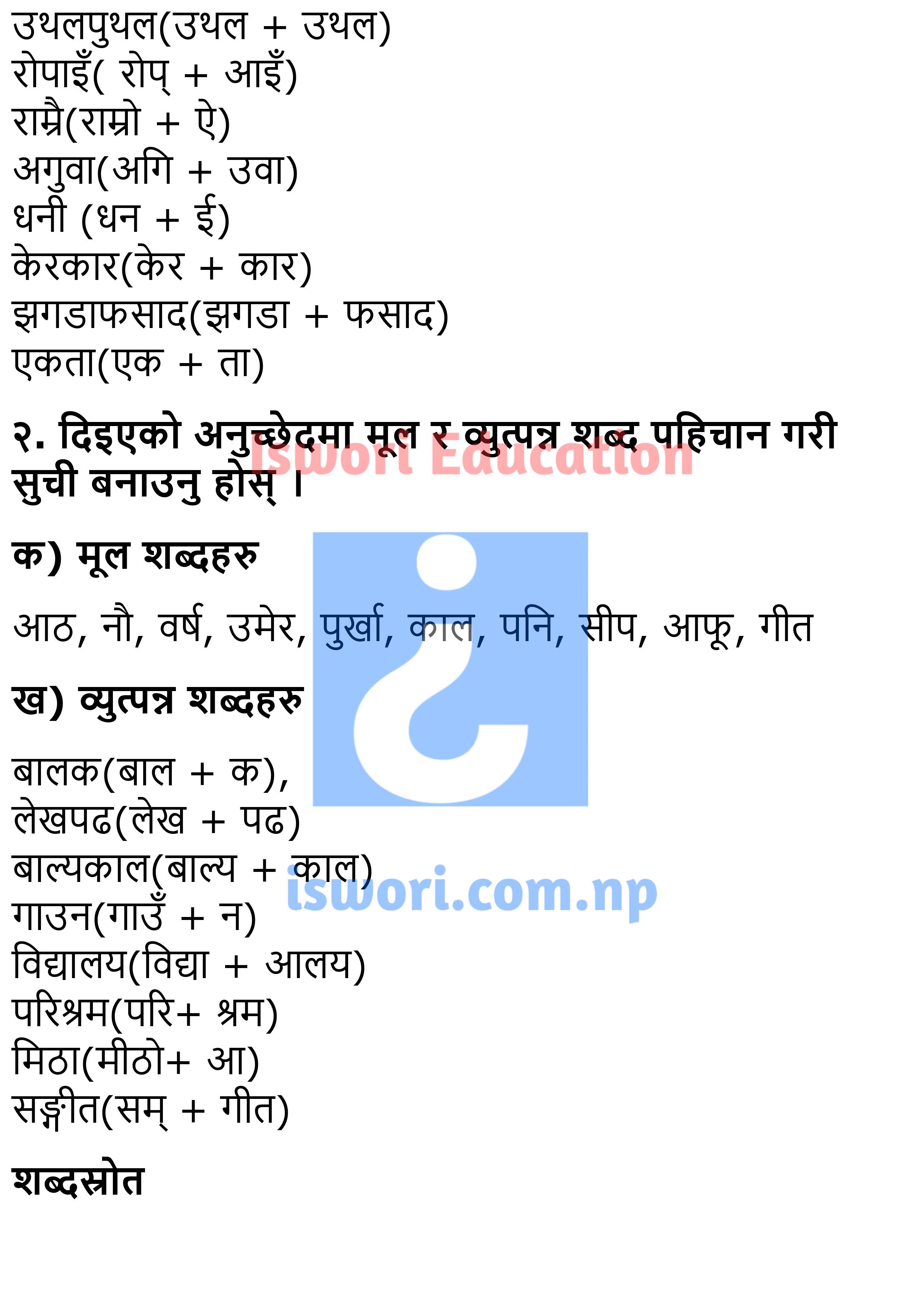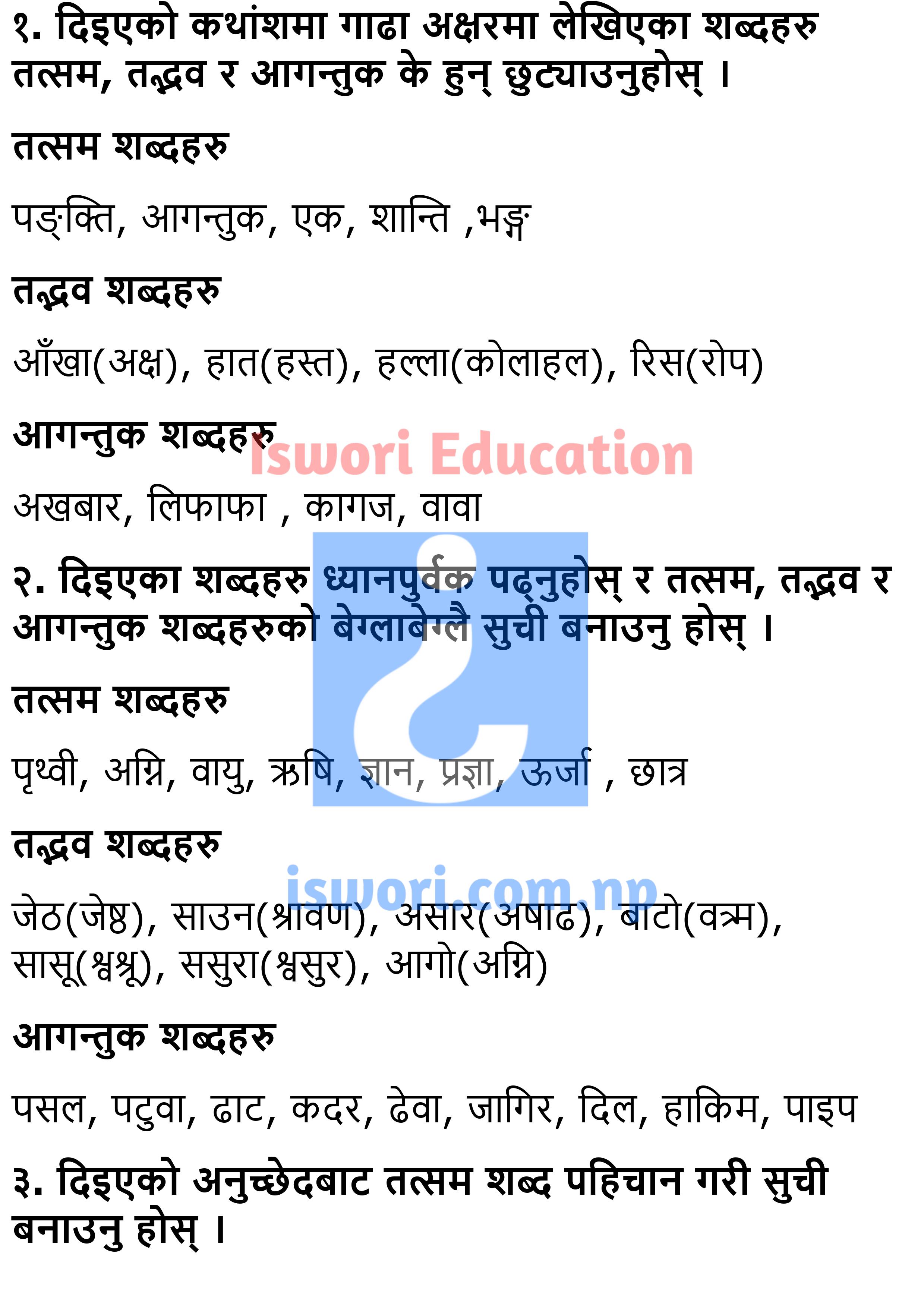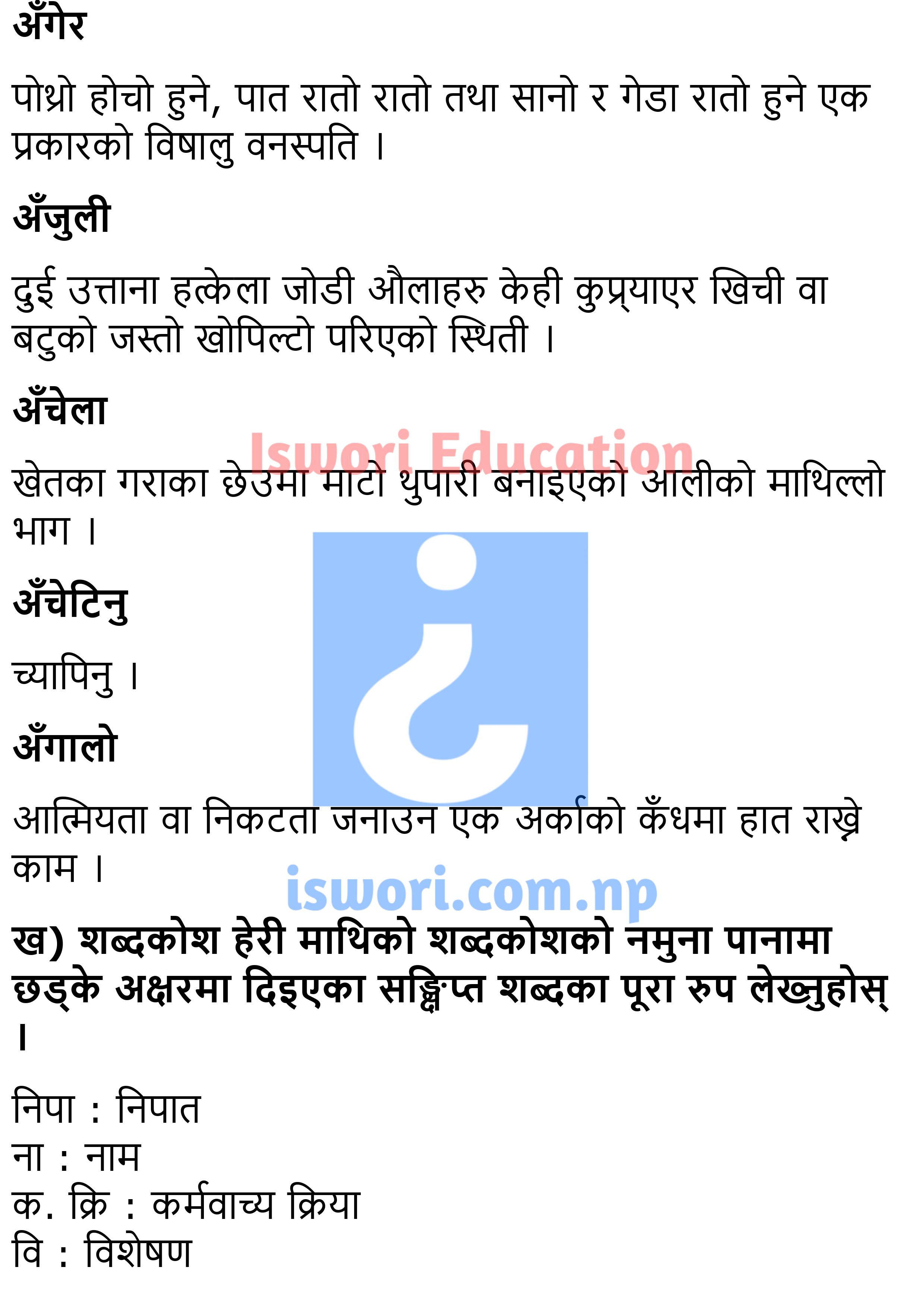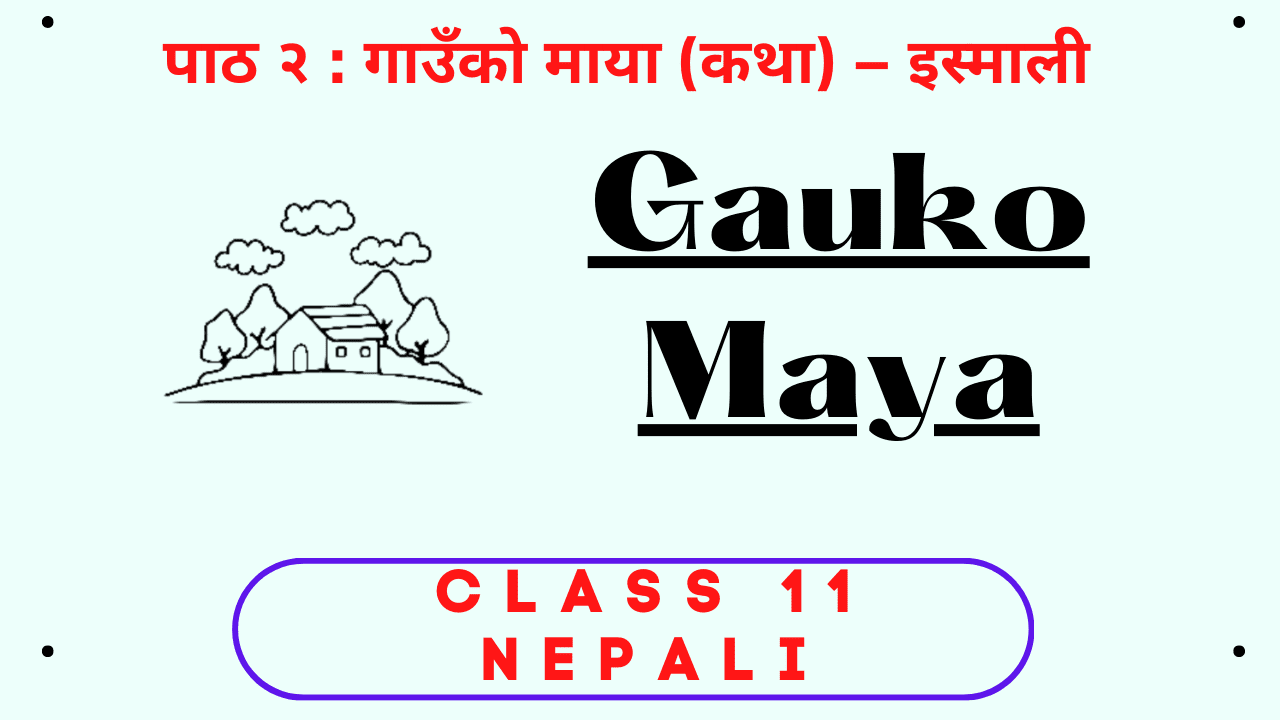 |
| Gauko Maya Exercise Summary: Class 11 Nepali Chapter 2 |
Class 11 Nepali Chapter 2 Exercise: Gauko Maya
"Gauko Maya" is a Story Written by Maheshwar Prasad Upadhaya (Ismali), Which is in 2nd Chapter of Class 11 Nepali Curriculum. The title "Gauko Maya" translates to "Village's Love" in English, and reflects the central theme of the story. The story is set in a rural area of the Central Terai region of Nepal and highlights the issues of class discrimination and economic inequality in Nepali society.
Check:
Class 11 Model Question (All Subject)
Class 11 Nepali Model Question 2080 (With Solution)
Gauko Maya Author: Ismali (Maheshwar Prasad Upadhyay)
Ismali, also known as Maheshwar Prasad Upadhyay, was born on 2012 Jestha 4 in Aurahi, located in the Mahottari District of the Janakpur Zone. His parents are Govindprasad Upadhyay and Tilkumari Devi Poudel.
Ismali is highly educated and holds a postgraduate degree in Mathematics. He has put his education to good use by serving as a teacher at Sanothimi Campus in Bhaktapur.
Ismali is a talented writer and has authored several major novels, including "Seto Atanka" and "Zero Mile". His writing has garnered widespread acclaim and has established him as a leading figure in Nepali literature.
Gauko Maya Exercise : Question Answers and Grammar
To help class 11 Nepali Students to have better understanding of the story GAUKO MAYA, We provide summary, answer question, solution in pdf, given as:
Sabda Bhandar
Bodha ra aabyakti
Byakaran
Gauko Maya Summary
Gau ko maya is an excellent social story structured in the rural social environment and surroundings of the Midwest Terai. The protagonist of this story, Krishna, has to stay away from his homeland. On his way back home after two years, he has felt the pain of being away from their homeland. The dialogue between the characters make the story more interesting.
In this story, "Sahumahajan, Thalu" , a landlord who feeds the rural simple citizens, adopts the British policy of taking advantage of poverty and ruling. The main theme is class discrimination and the exploitation of the underprivileged by the privileged. This story seeks to portray the fact that the oppressed class must unite for the liberation of the proletariat, and that education or consciousness is the basis of social change. Returning to the village after about two years, main character Krishna is walking towards the village remembering his friends, relatives and many childhood incidents.
Krishna has felt the pain of leaving the village. Remembering the letter sent by his brother, he thinks that the youth are gradually awakening and the villagers are beginning to appreciate the value of life. They want change so that something can happen in their village. In the letter, Parichan complains that krishna has become a big man and if he has stayed stayed in village, they would have got a chance to know a few things.
In the journey, kirshna meets Parichan, who is plowing the field. He remembers the childhood activities spent with Parichan. The villagers sent krishna to study as Krishna is clever and quick to pick things up. They urged him to have a better future. The fact that the ancestral work of the poor and the ritual of being a shepherd's plow is traditionally handed over to the descendants also applies to the fact that it applies to the children of the family.
Wiping away the sweat, he remembers the past days of going to the river to fetch water. He remembers the character spending the last half of his life grazing and playing in the river. The love of the homeland melts away. The so-called Sahumahajan and Thalu exploiters and feudal lords seem to have divided and ruled the poor villagers of the impoverished proletariat by adopting the British policy of divide and rule.
The feudal thinking is that the poor will always be poor, destitute and uneducated. They know that there are three parties in the village. Seeing the awakening of consciousness in the environment has become unbearable for the so-called Thalu.
Feudal thinking is found in Thalu that the Parichans should remain parichans, should be plowed shepherds and should be favored. During the strike over the issue of four kilos of bunny, the work was halted for three days but it was Fekan and Shanichar who led the movement. It seems that the rich people tempted them to give them four manas of paddy and sold the movement. Later, when they did not get more than one mind, they have formed a separate party which depicts how the rich fulfill their selfish interests by dividing the poor. The facts are indicated.
Due to lack of education and consciousness, the citizens of the proletariat are still enslaved by the Sahu Mahajans and Thalus and no matter how many movements for liberation, the leadership has betrayed the party. And despite the law, the destiny of the poor has not changed. The poor have to live a life of slavery as a result of a lack of consciousness, a lack of value for labor, and suffering.
The standard of living will not change unless the poor citizens unite and raise their voices for rights and liberation. Expecting help from Krishna, whom Parichan had read, seems to have made him realize the importance of education.
Krishna's sense of responsibility towards the village means that an educated person should be involved in the development of his village, have power not in feet, but in personal interests for the benefit of the class, make the motherland his work place, and education is the basis of change.
What You Learned from this Post about "Gau Ko Maya"?
- "Gau Ko Maya" is a social story set in the rural Midwest Terai of Nepal.
- The protagonist, Krishna, experiences the pain of being away from his homeland.
- The story highlights class discrimination and the exploitation of the underprivileged by the privileged.
- The landlord Sahumahajan and Thalu adopt a British policy of divide and rule to exploit rural citizens.
- Education and consciousness are crucial for social change and the liberation of the oppressed.
- Krishna's sense of responsibility towards his village serves as a reminder for educated individuals to get involved in their hometown's development.
- Lack of education and consciousness still enslaves the poor, but their standard of living can improve if they raise their voices for rights and liberation.
What Topics are Covered in this Story's Note about Gauko Maya, Class 11 Nepali?
- Gauko Maya Summary
- Class 11 Nepali Book Chapter 2 Gauko Maya
- Gauko Maya Katha Exercise
- Gauko Maya Class 11 Byakaran
- Gauko Maya Class 11 Writer
- Gauko Maya Solutions for Class 11
Read More:
Chapter 3: Sanskriti Ko Naya Yatra ExerciseGauko Maya FAQs
What is "Gauko Maya" about?
"Gauko Maya" is the second chapter of the Class 11 Nepali curriculum. It's a story written by Ismali (Maheshwar Prasad Upadhyay) that explores the theme of class discrimination and economic inequality in Nepali society. The story is set in a rural area of the Central Terai region of Nepal.
Who is the author of "Gauko Maya"?
The author of "Gauko Maya" is Ismali, also known as Maheshwar Prasad Upadhyay. He is a talented writer with a postgraduate degree in Mathematics. Ismali has gained recognition for his contributions to Nepali literature.
What is the central theme of "Gauko Maya"?
The central theme of "Gauko Maya" is class discrimination and the exploitation of the underprivileged by the privileged. It highlights the need for education and consciousness as the basis for social change and liberation of the oppressed.
Can you provide a summary of "Gauko Maya"?
Certainly. "Gauko Maya" is a social story set in the rural Midwest Terai of Nepal. The protagonist, Krishna, returns home after two years away and experiences the pain of being separated from his homeland. The story portrays the exploitation of the poor by the privileged, especially through the characters Sahumahajan and Thalu. It emphasizes the importance of education and consciousness for social change.
What are the key points to remember from the summary of "Gauko Maya"?
- The story is set in rural Nepal.
- The protagonist, Krishna, returns home after two years and feels the pain of leaving his homeland.
- Class discrimination and the exploitation of the underprivileged are highlighted.
- Sahumahajan and Thalu use a divide-and-rule policy to exploit the villagers.
- Education and consciousness are essential for social change and liberation.
- Krishna's sense of responsibility toward his village underscores the importance of educated individuals contributing to their hometown's development.
What does "Gauko Maya" teach us?
"Gauko Maya" teaches us about the prevalence of class discrimination, exploitation, and the importance of education and consciousness for societal change. It emphasizes the need for unity among the oppressed and the role of educated individuals in contributing to the development of their communities.
What is the significance of Krishna's sense of responsibility toward his village?
Krishna's sense of responsibility toward his village underscores the idea that educated individuals should actively contribute to the development of their communities. It suggests that education should not only lead to personal gain but also be used to uplift the entire society.
How does "Gauko Maya" relate to Nepali society?
"Gauko Maya" reflects the social issues of class discrimination and economic inequality prevalent in Nepali society. It sheds light on the exploitation faced by the underprivileged and the need for education and consciousness to drive positive change.
Who are Sahumahajan and Thalu in "Gauko Maya"?
Sahumahajan and Thalu are characters in the story who represent the privileged class exploiting the underprivileged villagers. They adopt a divide-and-rule policy to maintain their power and economic advantage.
What is the message of "Gauko Maya" regarding social change?
The message of "Gauko Maya" is that education and consciousness are essential for bringing about social change and liberating the oppressed. It highlights the importance of unity among the underprivileged and the role of educated individuals in contributing to societal development.
How does "Gauko Maya" connect with Ismali's other works?
While "Gauko Maya" is a standalone story, it shares themes of social issues and exploitation with Ismali's other major novels, such as "Seto Atanka" and "Zero Mile." These works collectively highlight societal challenges and the need for change.
How does the story of "Gauko Maya" address the issue of class discrimination?
The story addresses the issue of class discrimination by portraying the exploitation of the underprivileged villagers by the privileged class. It highlights how the powerful take advantage of the poor and maintain their dominance through tactics like divide and rule.
What is the role of education in "Gauko Maya"?
Education is presented as a crucial factor for social change in "Gauko Maya." It is depicted as a means to awaken consciousness, unite the oppressed, and empower individuals to challenge exploitation and work towards a better future.
How does Krishna's journey in "Gauko Maya" symbolize societal change?
Krishna's journey back to his village in "Gauko Maya" symbolizes a return to his roots and an awakening to the realities of his society. His reflections and interactions with characters like Parichan highlight the need for change and the role of education in achieving it.







